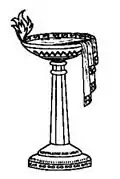Satish Ranjan Das
Satish Ranjan Das (1870–1928) was the Advocate-General of Bengal and later the Law Member of the Executive Council of the Viceroy; he was sometime treasurer of the Boy Scouts of Bengal and the Lodge of Good Fellowship, and a prominent member of the reformist Brahmo Samaj in Bengal. Das was part of a group of moderate Indian nationalists that sought to create a "British-style" public school in India, which ultimately led, after his death, to the creation of The Doon School.
Satish Ranjan Das | |
|---|---|
 A Portrait of Das | |
| Born | 27 June 1870 Naihati, Bengal Presidency, British India |
| Died | 26 October 1928 (aged 58) Kolkata, Bengal Presidency, British India |
| Occupation | Magistrate, Writer, lecturer |
| Parent(s) | Durga Mohan Das |
| Relatives | Chittaranjan Das Sudhi Ranjan Das Atul Prasad Sen |
Early life and career
After completing school and university education in England, Das returned to India in 1894. The idea of The Doon School originated from his participation in the"growing search for a national Indian identity."[1]
Although he died seven years before the school actually opened, Das and others in his informal group had lobbied for it during the 1920s. Das and the rest of the group envisaged an Indian school patterned on the British public school, which he felt had effectively trained young men to become responsible and resourceful administrators throughout the British Empire. But in contrast to British schools, the founders of the Doon School wanted an Indian school to be nonsectarian and responsive to Indian aspirations. The founders saw Doon as the training ground for a new generation of Indian leaders who would take over the reins of administration and government following Independence.
By copying the model of the British public school, the founders were attempting to show that Indians could compete with the British on their own terms without relinquishing their national or cultural identity. This reflected the views of many Indian leaders and intellectuals of the time, but certainly not all. Characteristically, Jawaharlal Nehru welcomed the creation of the school but Mohandas K. Gandhi would have nothing to do with it.[2]
In 1922, Das he was appointed Advocate-General of Bengal.[3] In 1927, he became a member of the Viceroy's Executive Council of Lord Irwin.
Personal life
Das was born in 1870 to Durga Mohan Das, a social reformer. He belonged to the Baidya Das family of Telirbagh, Bikrampur, Dhaka, now in Bangladesh. He was cousin to Chittaranjan Das and Sudhi Ranjan Das (Chief Justice of India). Das's two sisters were Sarala Roy who founded the Gokhale Memorial School in Calcutta, and Abala Bose, wife of scientist Jagadish Bose.
Das was married to Bonalata Devi. One of his grandsons, Shomie Das, went on to serve as headmaster of The Doon School.
Death
In the summer of 1928, SR Das spent a good deal of his time in England visiting schools and discussing his scheme with well known educationists. Towards the end of that summer, he returned to India and went to Shimla to resume his duties. He soon became unwell and died in Calcutta on 26 October 1928.
References
- "Origins & History". The DOON School. Archived from the original on 23 May 2009. Retrieved 5 April 2012.
- Sanjay Srivastava (1998). Constructing Post-colonial India: National Character and the Doon School. Routledge. pp. 21–. ISBN 978-0-415-17856-3.
- The Edinburgh Gazette. 7 November 1922. Page 701
Further reading
- Chopra, Radhika & Jeffery, Patricia M. (Eds.) (2005). Educational Regimes in Contemporary India. Sage Publications Inc. ISBN 0-7619-3349-2
\

